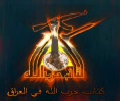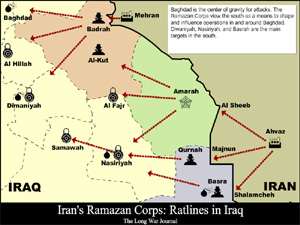|
|
|
Logo for the Hezbollah Brigades from a propaganda video released on the Internet. |
The US Treasury Department designated the Iraqi Hezbollah Brigades and a senior aide to Iran’s Qods Force as insurgent and militia entities that threaten to destabilize the security of Iraq.
Treasury designated Abu Mahdi al Muhandis and the Hezbollah Brigades under Executive Order 13438. Earlier today, the US Department of State also designated the Hezbollah Brigades as a terrorist entity under Executive Order 13224. Both executive orders allow the US to block financial transactions, freeze assets, and prosecute for terrorist activities.
Abu Mahdi al Muhandis is an adviser to Brigadier General Qassem Suleimani, the commander of Iran’s Qods Force, the special operations branch of the Islamic Revolutionary Guard Corps. Qods Force backs terror groups such Hezbollah in Lebanon, the Mahdi Army and the assortment of Special Groups in Iraq, and Hamas and Islamic Jihad in the Palestinian Territories.
As a senior Qods Force operative, Muhandis created a group of trainers to support the Mahdi Army Special Groups, such as the Asaib al Haq, or the League of the Righteous. “The groups received training in guerilla warfare, handling bombs and explosives, and employing weapons–to include missiles, mortars, and sniper rifles,” according to the Treasury press release.
Muhandis established smuggling networks to funnel weapons to the Mahdi Army Special Groups. He has supplied the deadly armor-piercing explosively formed projectiles, rockets, mortars, and sniper and assault rifles to the Iranian-backed Shia terror groups operating in Iraq. He is said to have directly aided the Mahdi Army during the Spring 2008 uprising against Iraqi and US forces in Sadr City, Maysan, and Basrah.
The Hezbollah Brigades, or Kata’ib Hezbollah, receives funding, training, logistics, guidance, and material support from the Qods Force.
For over two years, the Hezbollah Brigades has been active in and around Baghdad. The terror group has increased its profile by conducting attacks against US and Iraqi forces, using explosively-formed penetrators and improvised rocket-assisted mortars, which have been described as flying improvised explosive devices. The Hezbollah Brigades has posted videos of these attacks on the Internet.
Muhandis and the Hezbollah Brigades are the latest Iranian entities to be sanctioned by the US. In September 2008, the US sanctioned Abdul Reza Shahlai, a deputy Qods Force commander, and Akram Abas al Kabi, the leader of the League of the Righteous, along with three other individuals and two Iranian corporations for backing terror activities in Iraq. Qods Force was labeled a Specially Designated Global Terrorist entity in October 2007.
Iranian activity in Iraq
|
Flash Presentation on the Ramazan Corps and the Iranian Ratlines into Iraq. Click the map to view. A Flash Player is required to view, click to download. |
Both the Iraqi government and the US military have said Iran has backed various Shia terror groups, including elements of the Mahdi Army. While the Iranian government has denied the charges, Iraqi and US forces have detained dozens of Iranian Qods Force officers and operatives, captured numerous Shia terrorist leaders under Iranian command, and have found ample documentation as well as Iranian-made and Iranian-supplied weapons.
US and Iraqi forces have captured several high-level Qods Force officers inside Iraq since late 2006. Among those captured are Mahmud Farhadi, one of the three Iranian regional commanders in the Ramazan Corps; Ali Mussa Daqduq, a senior Lebanese Hezbollah operative; Qais Qazali, the leader of the Qazali Network, which is better known as the Asaib al Haq or the League of the Righteous; and Azhar al Dulaimi, one of Qazali’s senior tactical commanders. The US has imposed sanctions on Major General Ahmad Foruzandeh, the former Qods Force commander, and Abdul Reza Shahlai, a deputy commander in Iran’s Qods Force, for backing Shia terror groups inside Iraq.
Since mid-October 2008, Iraqi and US forces have killed one Qods Force operative and captured 14 during raids throughout southern and central Iraq.
Qods Force, the special operations branch of the Islamic Revolutionary Guards Corps, has supported various Shia militias and terror groups inside Iraq, including the Mahdi Army. Qods Force helped to build the Mahdi Army along the same lines as Lebanese Hezbollah. Iran denies the charges, but captive Shia terrorists admit to having been recruited by Iranian agents and then transported into Iran for training.
Immediately after the fall of Saddam Hussein’s regime, Iran established the Ramazan Corps to direct operations inside Iraq. The US military says Iran and Lebanese Hezbollah have helped establish, fund, train, arm, and provide operational support for Shia terror groups such as the Hezbollah Brigades and the League of the Righteous. The US military refers to these groups, as well as the Iranian-backed elements of the Mahdi Army, as the “Special Groups.” These groups train in camps inside Iran.
US military officers believe that Iran is ramping up its operations inside Iraq after Iran’s surrogates suffered a major defeat at the hands of the Iraqi military during the spring and summer of 2008. Iraqi troops went on the offensive against the Mahdi Army and other Iranian-backed terror groups in Baghdad, Basrah, and central and southern Iraq. More than 2,000 Mahdi Army members were killed and thousands more were wounded. The operation forced Muqtada al Sadr to agree to a cease-fire, disband the Mahdi Army, and pull the Sadrist political party out of the provincial elections. Sadr’s moves caused shock waves in the Mahdi Army, as some of the militia’s leaders wished to continue the fight against US forces in Baghdad and in southern and central Iraq.
The League of the Righteous is a splinter group that broke away from Muqtada al Sadr’s Mahdi Army after Sadr announced in June 2008 that he would disband the Mahdi Army and formed a small, secretive military arm known as the Brigade of the Promised Day to fight Coalition forces. The Brigade of the Promised Day is said to number roughly 200 followers. There are few reported instances of attacks against US forces by the Brigade of the Promised Day.
Sadr loyalist Qais Qazali was commander of the League of the Righteous up until his capture in 2007. It is now under the command of Akram Abas al Kabi, a former Sadr loyalist.
The League of the Righteous receives funding, training, weapons, and direction from the Qods Force. The League of the Righteous conducts attacks with explosively formed projectiles as well as with the more conventional roadside bombs.
The size of the League of the Righteous is unknown, but hundreds of members of the group were killed, captured, or fled to Iran during the Iraqi government offensive against the Mahdi Army from March to July of 2008, according to the US military.
Sadr is looking to pull the rank and file of the League back into the fold of the Sadr political movement. Earlier this year Sadr issued a message rejecting the US-Iraqi security agreement and said he “extends his hand to the mujahideen in the so-called Asaib but not their leaderships who have been distracted by politics and mortal life from the [two late] Sadrs and the interests of Iraq and Iraqis.”










4 Comments
SANCTION? OK! Whats next? If you want to sanction anyone and actually show results, go to Deerborn, Michigan. Lebanese Hezbollah has been getting money funneled from there for 20+ years. Oh, but Khataib Hezbollah is not Lebanese Hez. TRUE! BUT both are formed, armed, funded, and supported by IRAN!
Bill, anytime you get the word out about the stuff that Iran is doing, KUDOS. We need the average people to be educated about what we know on the ground. This subject is near and dear to me. Forgive my frustration in the first paragraph.
I wish we could all be more precise in distinguishing between ‘terrorist’ (one who tries to obtain politico-military results by creating fear in the civilian populace by random acts of violence) and ‘insurgent’ (one who uses irregular forces and guerrilla warfare techniques against regular army forces and acts as the military arm of a ‘shadow government’). Not all terrorists are insurgents; not all insurgents are terrorists.
Iran has been sticking it to us for years, cutting thier funding is just 1 of many things the US can/should do. Like hitting them INSIDE Iran. Look at the map, if its accurate, why not target them? Iraq is starting to unravel, it was bound to happen. All that for what? To let these swine roam freely acrosss the borders? Iran’s day of reckoning is near.
I have a background in intellingence and security, if I lived in Dearborn,MI. I would be conducting my own survelliance on the mosques with ties to Islamic terrorist groups.
Hezbollah is a bad group of actors, active in this hemisphere, thanks to Chavez. I am more concerned about a multiple stike on major US cities (i.e. Houston, LA, Phoenix, DFW metroplex, and San Diego) by Hezbollah entering the US from the southern border with the aid of the motley crew of leaders in Central and South America.
Chavez is a real problem, to US interest and security, and will eventually have to be dealt with in a very unpleasant manner. I am not implying direct US military involvement, but more along the lines of how Reagan dealt with Ortega in the 1980’s.